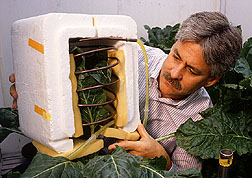This page has been archived and is being provided for reference purposes only. The page is no longer being updated, and therefore, links on the page may be invalid.
New Research Explains Signaling System for Plant NutrientsBy Linda McGrawMarch 10, 1999 New discoveries about how plants distribute nutrients internally could lead someday to crops that are more nutritious, can produce higher yields or overcome environmental challenges, Agricultural Research Service scientists report. Just like animals have a signaling system between the brain and the stomach to tell them when to stop or start eating, plants also have a special signaling system that regulates nutrient distribution. The “signaler” in the system is sucrose, the major form of sugar transported in the plant’s vascular system. The plant responds to sucrose’s signal by increasing or decreasing nutrient flow to roots, seeds, and storage organs--known as “sink” tissues. These tissues are called “sinks” because they import sugars and amino acids to support plant growth and development, according to ARS plant physiologist Daniel R. Bush. Bush works in the ARS Photosynthesis Research Unit at Urbana, Illinois. ARS is the chief scientific research agency of the USDA. When sucrose exits plant leaves, it flows through elongated structures called phloem cells, which lie end to end, forming a continuous conduit in the plant’s vascular system. A specialized sucrose transport protein loads the sugar into the phloem. Inside the phloem cells, the concentration of sucrose is 100 times greater than that outside. This attracts water into the cells. The release of sucrose into “sink” tissues causes the water to leave the phloem cells, creating a hydraulic pressure difference between the leaf and the sink phloem that drives long-distance nutrient transport. This is similar to the pressure-driven flow of blood pumped through the human body. A story about this research is in the March issue of Agricultural Research magazine, which can be found on the World Wide Web at /is/AR/archive/mar99/sugar0399.htm Scientific contact: Daniel R. Bush, ARS Photosynthesis Research Unit, Urbana, Ill., phone (217) 333-6109, fax (217) 244-4419, dbush@uiuc.edu |

